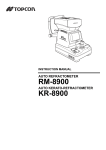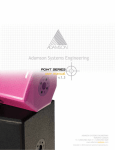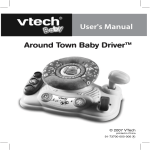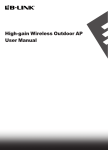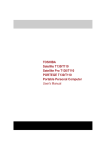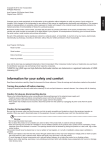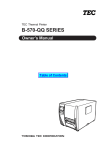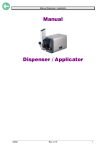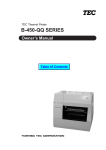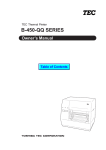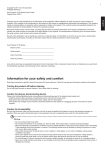Download Toshiba B-442 Barcode Reader User Manual
Transcript
TEC Bar Code Printer B-442 Owner's Manual Table of Contents LIST OF STANDARDS OF CONFORMITY (EU ONLY) Manufacturer : Toshoba TEC Corporation Address : 570 Ohito, Ohito-Cho, Tagata-Gun, Shizuoka-Ken, 410-2392 Japan declares that following product Product Name : Bar Code Printer Model : B-442-QP Options : All conforms to the following product specifications Generic Standard : EN50 082-1 Safety : EN 60 950 EMC : EN 55 022 IEC 801-2 IEC 801-3 IEC 801-4 Harmonics : EN 61000-3-2 EN 61000-3-3 Supplementary Information The product herewith complies with the requirements of the Low Voltage Directive 73/23/EEC, and the EMC directive 89/336/EEC. EM1-33046A Safety Summary Safety Summary Personal safety in handling or maintaining the equipment is extremely important. Warnings and Cautions necessary for safe handling are included in this manual. All warnings and cautions contained in this manual should be read and understood before handling or maintaining the equipment. Do not attempt to effect repairs or modifications to this equipment. If a fault occurs that cannot be rectified using the procedures described in this manual, turn off the power, unplug the machine, then contact your authorized TEC representative for assistance. Meanings of Each Symbol This symbol indicates warning items (including cautions). Specific warning contents are drawn inside the symbol. (The symbol on the left indicates a general caution.) This symbol indicates prohibited actions (prohibited items). Specific prohibited contents are drawn inside or near the symbol. (The symbol on the left indicates “no disassembling”.) This symbol indicates actions which must be performed. Specific instructions are drawn inside or near the symbol. (The symbol on the left indicates “disconnect the power cord plug from the outlet”.) WARNING Any other than the specified AC voltage is prohibited. This indicates that there is the risk of death or serious injury if the machines are improperly handled contrary to this indication. Do not use voltages other than the voltage (AC) specified on the rating plate, as this may cause fire or electric shock. Prohibited Do not plug in or unplug the power cord plug with wet hands as this may cause electric shock. Prohibited If the machines share the same outlet with any other electrical appliances which consume large amounts of power, the voltage will fluctuate widely each time these appliances operate. Be sure to provide an exclusive outlet for the machine as this may cause the machines to malfunction. Prohibited Do not place metal objects or water-filled containers such as flower vases, flower pots or mugs, etc. on top of the machines. If metal objects or spilled liquid enter the machines, this may cause fire or electric shock. Prohibited Do not insert or drop metal, flammable or other foreign objects into the machines through the ventilation slits, as this may cause fire or electric shock. Prohibited Do not scratch, damage or modify the power cords. Also, do not place heavy objects on, pull on, or excessively bend the cords, as this may cause fire or electrical shock. Disconnect the plug. If the machines are dropped or their cabinets damaged, first turn off the power switches and disconnect the power cord plugs from the outlet, and then contact your authorized TEC representative for assistance. Continued use of the machine in that condition may cause fire or electric shock. Disconnect the plug. Continued use of the machines in an abnormal condition such as when the machines are producing smoke or strange smells may cause fire or electric shock. In these cases, immediately turn off the power switches and disconnect the power cord plugs from the outlet. Then, contact your authorized TEC representative for assistance. (i) EM1-33046A Safety Summary Disconnect the plug. Connect a grounding wire. If foreign objects (metal fragments, water, liquids) enter the machines, first turn off the power switches and disconnect the power cord plugs from the outlet, and then contact your authorized TEC representative for assistance. Continued use of the machine in that condition may cause fire or electric shock. Disconnect the plug. When unplugging the power cords, be sure to hold and pull on the plug portion. Pulling on the cord portion may cut or expose the internal wires and cause fire or electric shock. Ensure that the equipment is properly grounded. Extension cables should also be grounded. Fire or electric shock could occur on improperly grounded equipment. No disassembling. Do not remove covers, repair or modify the machine by yourself. You may be injured by high voltage, very hot parts or sharp edges inside the machine. indicates that there is the risk of personal Injury or damage to CAUTION This objects if the machines are improperly handled contrary to this indication. Precautions The following precautions will help to ensure that this machine will continue to function correctly. • Try to avoid locations that have the following adverse conditions: * Temperatures below 0°C and above 40°C * Direct sunlight * Shared power source * Excessive vibration • The cover should be cleaned by wiping with a dry cloth or a cloth slightly dampened with a mild detergent solution. NEVER USE THINNER OR ANY OTHER VOLATILE SOLVENT on the plastic covers. • USE ONLY TEC SPECIFIED paper and ribbons. • DO NOT STORE the paper or ribbons where they might be exposed to direct sunlight, high temperatures, high humidity, dust, or gas. • Ensure the printer is operated on a level surface. • Any data stored in the memory of the printer could be lost during a printer fault. • Try to avoid using this equipment on the same power supply as high voltage equipment or equipment likely to cause mains interference. • Unplug the machine whenever you are working inside it or cleaning it. • Keep your work environment static free. • Do not place heavy objects on top of the machines, as these items may become unbalanced and fall causing injury. • Do not block the ventilation slits of the machines, as this will cause heat to build up inside the machines and may cause fire. • Do not lean against the machine. It may fall on you and could cause injury. Request Regarding Maintenance • Utilize our maintenance services. After purchasing the machine, contact your authorized TEC representative for assistance once a year to have the inside of the machine cleaned. Otherwise, dust will build up inside the machines and may cause a fire or a malfunction. Cleaning is particularly effective before humid rainy seasons. • Our preventive maintenance service performs the periodic checks and other work required to maintain the quality and performance of the machines, preventing accidents beforehand. For details, please consult your authorized TEC representative for assistance. • Using insecticides and other chemicals (ii) EM1-33046A TABLE OF CONTENTS Page 1. 2. INTRODUCTION ................................................................................................ 1- 1 1.1 APPLICABLE MODEL ............................................................................... 1-6 1.2 UNPACKING AND INSPECTION.............................................................. 1-6 1.3 EQUIPMENT CHECKLIST ........................................................................ 1-6 SPECIFICATIONS ............................................................................................... 2-1 2.1 PRINTER ................................................................................................... 2-1 2.2 OPTIONS .................................................................................................. 2-2 2.3 MEDIA ....................................................................................................... 2-3 2.4 RIBBON ..................................................................................................... 2-4 2.5 CARE/HANDLING OF THE MEDIA AND RIBBON ................................... 2-5 3. OVERVIEW ......................................................................................................... 3-1 3.1 PRINTER PARTS ...................................................................................... 3-1 3.2 EXTERNAL LABEL ROLL MOUNT ........................................................... 3-3 3.3 SWITCHES AND INDICATOR LIGHTS .................................................... 3-4 4. 5. DIP SWITCH FUNCTIONS .................................................................................. 4-1 SET UP PROCEDURE ........................................................................................ 5-1 5.1 REQUIREMENTS FOR OPERATION ....................................................... 5-1 5.2 SETTING UP THE PRINTER .................................................................... 5-1 6. 7. 8. LOADING LABEL AND TAG STOCK .................................................................. 6-1 SELF-PEELING FUNCTION ............................................................................... 7-1 RIBBON LOADING INSTRUCTIONS .................................................................. 8-1 9. 10. 11. INSTALL EXTERNAL LABEL ROLL MOUNT ..................................................... 9-1 INSTALL MEMORY MODULE ........................................................................... 10-1 SELF TEST ........................................................................................................ 11-1 12. 13. DUMP MODE .................................................................................................... 12-1 GENERAL MAINTENANCE .............................................................................. 13-1 13.1 CLEANING .............................................................................................. 13-1 13.2 COVERS AND PANELS ......................................................................... 13-2 13.3 REMOVING JAMMED MEDIA ................................................................ 13-2 13.4 DENSITY ADJUSTMENT.........................................................................13-2 14. TROUBLESHOOTING ....................................................................................... 14-1 15. ERROR MESSAGES ......................................................................................... 15-1 16. HOW TO CONNECT THE PRINTER WITH PORTABLE LCD KEYBOARD ..... 16-1 CAUTION: 1. This manual may not be copied in whole or in part without prior written permission of TEC. 2. The contents of this manual may be changed without notification. 3. Please refer to your local Authorized Service representative with regard to any queries you may have in this manual. Copyright © 1999 by TOSHIBA TEC CORPORATION All Rights Reserved 570 Ohito, Ohito-cho, Tagata-gun, Shizuoka-ken, Japan EM1-33046A 1. INTRODUCTION 1. INTRODUCTION 1. INTRODUCTION Thank you very much for purchasing the TEC B-442 Bar Code Printer. The attractive desktop printer delivers superior performance at an economical price. Both powerful and easy-to-use, the B-442 printer is your best choice among industrial direct thermal and thermal transfer label printers. The B-442 offers both high-resolution thermal transfer and direct thermal printing at selectable speeds of 1.5 inches and 2 inches per second. It can accept a wide range of media, including roll feed, die-cut, and fan-fold labels, tags or tickets for both thermal transfer and direct thermal printing. All of the most frequently used bar code formats are resident in this printer’s memory and can be printed with human readable bar code interpretations. Character fonts and bar codes can be printed in any one of four directions. The B-442 provides a choice of five different alphanumeric fonts in variable sizes; by using font multiplication, an even greater range of sizes is possible. Smooth fonts can be downloaded from the user-friendly, Windows "Free Label Software". In addition, the B-442 is capable of independently executing Basic programming functions, including arithmetic, logical operation, loop, flow-control and file management, among others. This programming capability provides the greatest efficiency in label printing. This printer also completes its own Self Test, insuring superior performance at all times. The status of printer and error messages may either be printed out or viewed on a monitor by means of an RS-232 connection. Features • Thermal transfer and direct thermal printing • High dot density printing (203 dots/inch, 8 dots/mm) • Selectable print speed of 1.5 inches or 2 inches per second • Large maximum media width size: 4.53 inches (115 mm) • International character sets • Print area is 4.09 inches wide x 4.56 inches long (104 mm x 116 mm). Longer media formats up to 23.19 inches long (589 mm) may be printed with optional memory module. • User selectable bar code ratios and heights • Printing on label, tags or ticket stock • Black mark sensor (option) • Self-peeling mode • Label stock and thermal transfer ribbon easy to load • Internal label print counter • Self Test • Protocol-XON/XOFF; CTS/DTR handshaking • Downloadable soft fonts from the Windows label and tag design "Free Label Software" This manual contains general set-up and maintenance information and should be read carefully to help gain maximum performance and life from your printer. For most queries please refer to this manual and keep it safe for future reference. 1-1 EM1-33046A 1. INTRODUCTION 1. INTRODUCTION This equipment has been tested and found to comply with the limits for a Class A digital device, pursuant to Part 15 of the FCC Rules. These limits are designed to provide reasonable protection against harmful interference when the equipment is operated in a commercial environment. This equipment generates, uses, and can radiate radio frequency energy and, if not installed and used in accordance with the instruction manual, may cause harmful interference to radio communications. Operations of this equipment in a residential area is likely to cause harmful interference in which case the user will be required to correct the interference at his own expense. (for USA only) Changes or modifications not expressly approved by manufacturer for compliance could void the user's authority to operate the equipment. "This Class A digital apparatus meets all requirements of the Canadian Interference-Causing Equipment Regulations." "Cet appareil numérique de la classe A respecte toutes les exigences du Règlement sur le matériel brouilleur de Canada." (for CANADA only) WARNING! This is a Class A product. In a domestic environment this product may cause radio interference in which case the user may be required to take adequate measures. WARNING! Battery may explode if mistreated. Do not recharge, disassemble or dispose of in fire. CAUTION: Do not touch moving parts. To reduce the risk that fingers, jewelry, clothing. etc., be drawn into the moving parts, push the switch in the "OFF" position to stop movement. Safety Summary Personal safety in handling or maintaining the equipment is extremely important. Warnings and Cautions necessary for safe handling are included in this manual. All warnings and cautions contained in this manual and written inside or outside of the printer should be read and understood before handling or maintaining the equipment. Do not attempt to effect repairs to this equipment. If a fault occurs that cannot be rectified using the procedures described in this manual, turn off the power, unplug the machine, then contact your authorised TEC representative for assistance. 1-2 EM1-33046A 1. INTRDUCTION 1.1 APPLICABLE MODEL 1.1 APPLICABLE MODEL B - 4 4 2 - Q Q Destination Code QQ: North America QP: Europe GH12-GB: UK Thermal direct/Thermal transfer 1.2 UNPACKING AND INSPECTION After receiving your B-442 Bar Code Printer, carefully inspect the device and its accessories. The B-442 is specially packaged to withstand damage in shipping. If damage is evident, a damage claim should be filed immediately with the transportation company. Please save the printer packaging materials in case you need to reship the printer in the future. 1.3 EQUIPMENT CHECKLIST • • • • • • • • • • • B-442 Bar Code Printer unit Ribbon supply/rewind spindle (2 pcs.) Ribbon paper core Ribbon rewind spindle Label supply roll spindle External label roll mount Power cord AC adapter RS232C Interface cable "Free Label" Software "Window Driver" Software If any parts are missing, contact your TEC representative for assistance. 1-6 EM1-33046A 2. SPECIFICATIONS 2.1 PRINTER 2. SPECIFICATIONS 2.1 PRINTER 2.1.1 Printer Block Type: Print Speed: Resolution: Font Styles: Bar Codes: 2D Codes: Direct thermal or thermal transfer 1.5 inches or 2.0 inches per second 203 dots per inch (8 dots per mm) Five alphanumeric fonts from 0.059 inches H (1.5 mm) to 0.23 inches (6.0 mm), expandable vertically and horizontally up to 8 times. Code 39, Code 93, Code 128 UCC, Code 128 (Subsets A, B and C), Codabar, Interleaved 2 of 5, EAN-8, EAN-13, UPC-A, UPC-E, EAN and UPC with 2 or 5 digit add-on, Postnet and Chinese Post Code Maxi Code, PDF-417 * PDF417 is a trademark of Symbol Technologies, Inc. 2.1.2 Media Width: Length: NOTE: 0.98 inches (25 mm) to 4.53 inches (115 mm) 0.47 inches (12 mm) to 10.75 inches (273 mm) In below case, effective print length may become shorter than 273 mm. • Use Windows font in " Free label" • Download logo, font, program into the printer memory. Thickness: Thermal Label ............ 0.003 inches (0.08 mm) to 0.018 inches (0.46 mm) Tag Paper, Ticket ....... 0.006 inches (0.16 mm) to 0.013 inches (0.32 mm) Type: Roll-feed, die-cut or fan-fold labels, tags or tickets Supply Roll Capacity: 4.3 inches (110 mm) maximum diameter on a 1 inches (25.4 mm) core. External roll mount will accommodate larger rolls up to a maximum diameter of 8.4 inches (214 mm) on a 1 inches (25.4 mm) core or 6.4 inches (163 mm) on a 3 inches (76.2 mm) core Thermal Transfer Ribbon: Black, 300 m long 2.1.3. Indicators and Switches Indicator Lights: Power, On-line, Error Switches: Power, Pause, Feed, Rear Dip Switch (Thermal Transfer/Direct Thermal Printing Switch, Black Mark/Gap Sensing Switch, Communication setting) NOTE: The functions of Pause, Feed switches and LED indicator lights may be redefined by command. 2-1 EM1-33046A 2. SPECIFICATIONS 2.2 OPTIONS 2.1.4 Communications Interface Communications: Character Set: Word Length: Handshaking: Input Buffer: 2.1.5 RS-232C (DB-9) at 2400, 4800, 9600 or 19200 baud ANSI ASCII character set 7 or 8 data bits, 1 or 2 stop bits, selectable parity XON/XOFF (on receive mode only) and CTS/DTR 2 K bytes Electrical Parts Input voltage: Switching power, 100~240 VAC ±10%, single phase 50/60 Hz Circuit Protection: 2A maximum Grounding: Unit must be connected to a properly grounded receptacle 2.1.6 Environment Operating Temperature: 5°C to 40°C Storage Temperature: -10°C to 60°C Humidity: 25% to 85% ( 2.1.7 ) Body Size: Weight: 6.14 inches H x 9.13 inches W x 11.73 inches D (15.6 cm H x 23.2 cm W x 29.8 cm D); with external roll mount 17.95 inches D (45.6 cm D) 4.85 lb. (2.2 kg), and with external roll mount 5.38 lb. (2.45 kg) 2.2 OPTIONS A number of different options may be added to the B-442 Bar Code Printer for even greater convenience and versatility. Option Name Model No. or Part No. Description Source Memory Module B-5704-EM-QM Expandable RAM memory module (384KB) with Date/Time clock. See Note 1 Black Mark Sensor Part No. FMYH0013901 Attaching this sensor to the printer alls a detection of black marks on media. See Note 2 NOTES: 1. Contact TEC H.Q. or your nearest TEC representative. 2. Order from TEC Parts Center. 2-2 EM1-33046A 2. SPECIFICATIONS 2.3 MEDIA 2.3 MEDIA Type Tag Paper Ticket 25.0 ~ 115.0 25.0 ~ 115.0 25.0 ~ 115.0 Length (mm) 12.0 ~ 273.0 12.0 ~ 273.0 12.0 ~ 273.0 Thickness (mm) 0.08 ~ 0.46 0.16 ~ 0.32 0.16 ~ 0.32 Item Width (mm) Thermal Label Inner roll diameter (mm) 110.0 max. External roll diameter (mm) 214.0 max. 1) Thermal Label <Design> 2.5 mm ~ 5.0 mm Backing Paper Label Label 1.0 mm 1.0 mm BackingPaper 23.0 mm~113.0 mm Fig. 2-1 25.7 ± 0.3 mm 12.0 mm ~ 273.0 mm Fig. 2-2 25.0 mm~115.0 mm 2) Tag Paper Sensing Hole <Design> 2.5 mm ~ 5.0 mm 25.7 ± 0.3 mm 12.0 mm ~ 273.0 mm Fig. 2-4 Print Side Fig. 2-3 25.0 mm~115.0 mm 3) Ticket Black Line <Design> 3.0 mm ~ 30.0 mm 25.7 ± 0.3 mm 12.0 mm ~ 273.0mm Fig. 2-6 Fig. 2-5 Print Side 25.0 mm~115.0 mm 2-3 EM1-33046A 2. SPECIFICATIONS 2.4 RIBBON <Non Print Area> 1.0 mm Printing Area 1.0 mm 1.0 mm 1.0 mm Fig. 2-7 4) Relationship between the head effective print width and paper. Head effective print width 104.0 mm 115.0 mm (Maximum paper width) 2.4 RIBBON Item No. Specification 1 Shape Spool type 2 Width 40 mm ~ 110.0 mm 3 Max. OD 4 Winding method The ink side is outside of ribbon winding. Ø67 mm 2-4 EM1-33046A 2. SPECIFICATIONS 2.5 CARE/HANDLING OF THE MEDIA AND RIBBON <Core Shape> 25.7 ± 0.3 mm Fig. 2-8 Max. 105 ± 0.5 mm NOTE: When purchasing ribbon locally, they must meet the above size. There may be TEC-approved ribbons which do not fall within the above size, however, they have no functional problem. Base Treated back side Core Core Ink outside Adhesive tape Adhesive tape Adhesive tape Leader tape Fig. 2-9 Ink ribbon End tape (Non Transmissive) Connection between leader tape and ribbon 2.5 CARE/HANDLING OF THE MEDIA AND RIBBON CAUTION: Be sure to read carefully and understand the Supply Manual. Use only media and ribbon which meet specified requirements. Use of non-specified media and ribbon may shorten the head life and result in problems with bar code readability or print quality. All media and ribbon should be handled with care to avoid any damage to the media, ribbon or printer. Read the following guideline carefully. • • Do not store the media and ribbon for longer than the manufactures recommended shelf life. Store media rolls on the flat end, do not store them on the curved sides as this might flatten that side causing erratic media advance and poor print quality. • Store the media in plastic bags and always reseal after opening. Unprotected media can get dirty and the extra abrasion from the dust and dirt particles will shorten the print head life. • Store the media and ribbon in a cool, dry place. Avoid areas where they would be exposed to direct sunlight, high temperature, high humidity, dust or gas. • The thermal paper used for direct thermal printing must not have the specifications which exceed Na+ 800 ppm, K+ 250 ppm and CL- 500 ppm. • Some ink used on pre-printed labels may contain ingredients which shorten the print head’s product life. Do not use labels pre-printed with ink which contain hard substances such as carbonic calcium (CaCO3) and kaolin (Al2O3, 2SiO2, 2H 2O). For further information please contact your local distributor or your media and ribbon manufacturer. 2-5 EM1-33046A 3. OVERVIEW 3.1 PRINTER PARTS 3. OVERVIEW 3.1 PRINTER PARTS 2 5 3 6 4 7 1 Fig. 3-1 Top Front View 1. 2. 3. 4. 5. 6. 7. Cover Release Button Pause Switch Power, On-line and Error Indicator Lights Feed Switch Clear Viewing Window Label Dispense Opening Backing Paper Opening (for use with Self Peel Function) 3-1 EM1-33046A 3. OVERVIEW 3.1 PRINTER PARTS 3 2 5 4 6 1 10 9 11 8 12 4 7 13 Fig. 3-2 Interior View 1. Printer Cover (in open position) 2. Label Supply Roll Spindle 3. Memory Module Insert Slot (cover on) 4. Ribbon Mechanism 5. Ribbon Supply Spindle 6. Ribbon Rewind Spindle 1 7. Printer Carriage Release Lever 8. Backing Paper Opening 9. Removable Front Panel 10. Pause Switch 11. Power, On-line, Error Indicator Lights 12. Feed Switch 13. Label Taken Sensor 2 5 3 6 4 Fig. 3-3 Rear View 1. Power On/Off Switch 4. 8 Position Dipswitch 2. Power Supply Connector 5. Label Insert Opening (for use with external labels) 3. RS-232 DB-9 Interface Connector 6. Cover Hinge 3-2 EM1-33046A 3. OVERVIEW 3.2 EXTERNAL LABEL ROLL MOUNT 3.2 EXTERNAL LABEL ROLL MOUNT Fig. 3-4 External Label Roll Mount 3-3 EM1-33046A 3. OVERVIEW 3.3 SWITCHES AND INDICATOR LIGHTS 3.3 SWITCHES AND INDICATOR LIGHTS • INDICATORS PWR. (Power) Indicator The green PWR. indicator light will illuminate when the Power Switch is turned on. On-line Indicator The green On-line indicator will be on when the printer is ready to print. When the Pause button is pressed, the On-line light will flash. ERR. (Error/Paper Empty) Indicator The red ERR indicator light will illuminate at a printer error, such as memory error, command format error, and so on. For a full list of error messages, consult Section 15. TROUBLESHOOTING. The ERR. light flashes when the paper/ribbon has been used up. • SWITCHES Pause Switch The Pause switch allows the user to stop a print job and then continue printing with a second depression of the switch. By pressing the Pause switch: (1) the printer will stop printing after the label being printed is complete, (2) the Pause light will flash, and (3) the printer will hold all data in memory. This allows for trouble-free replacement of label stock and thermal transfer ribbon. A second depression of the Pause switch will restart the printer. If the Pause switch is held pressed for longer than 3 seconds, the printer will be reset and all stored data of last printing job will be deleted. Feed Switch Pressing the Feed switch will cause the label paper to advance to the first print position of the next label. Thermal Transfer/Direct Thermal Printing Switch Switch 7 on the dipswitch located on the rear of the printer allows the user to switch between thermal transfer and direct thermal printing. For thermal transfer printing, set the switch to off. For direct thermal printing, set the switch to on. Black Mark /Gap Sensing Switch Switch 8 on the dipswitch located on the rear of the printer allows the user to select either black mark or gap sensing. For black mark sensing, set the switch to off. For gap sensing, set the switch to on. 3-4 EM1-33046A 4. DIP SWITCH FUNCTIONS 4. DIP SWITCH FUNCTIONS 4. DIP SWITCH FUNCTIONS The DIP switches are located on the rear of the printer. <Rear View> WARNING! Turn the POWER OFF before changing the DIP switch settings. ON 1 2 3 4 5 6 7 8 Baud 19200 9600 4800 2400 SW-1 SW-2 OFF OFF ON OFF OFF ON ON ON Table 4-1 Baud Rate Parity None Even Odd SW-3 OFF ON ON SW-4 OFF OFF ON Table 4-2 Parity Data Bits 8 7 Stop Bits 1 2 SW-5 OFF ON SW-6 OFF ON Table 4-3 Date Bit Table 4-4 Stop Bit Printing Mode Thermal Transfer Direct Thermal Sensor SW-7 OFF ON SW-8 Black Mark OFF Through ON Table 4-6 Sensor Type Table 4-5 Printing Mode NOTE: The shaded settings are the factory default. 4-1 EM1-33046A 5. SET UP PROCEDURE 5.1 REQUIREMENTS FOR OPERATION 5. SET UP PROCEDURE 5.1 REQUIREMENTS FOR OPERATION The B-442 has the following requirements: • The host computer must have a serial port. • To set up the initial printer configuration, use either the keyboard on the printer or the DIP switch. • To print the format, create the complete program refering to the command manual. 5.2 SETTING UP THE PRINTER WARNING! 1. Be sure to use the enclosed AC adapter. Use of other AC adapters may cause fire or machine failure. 2. Do not use the enclosed AC adapter on the other equipment. 3. Be sure to close the printer cover while the printer is in use . Do not insert or drop any foreign substances or metal object into the printer, as this may cause fire or machine failure. CAUTION: The socket-outlet shall be installed near the equipment and shall be easily accessible. 1. Place the printer on a flat and secure surface. 2. Make sure the power switch is off. 3. Using the enclosed serial RS-232C cable, connect the printer to your computer. 4. Insert the DC plug of the AC adapter into the power supply connector on the printer. 5. Plug the AC adapter power cord into a properly grounded power outlet. 6. Turn on the power switch. The green power indicator light should illuminate. The printer is now ready to load labels. n RS-232C SERIAL INTERFACE Host Function RxD TxD DTR GND DSR RTS CTS 9 Pin 25 Pin 2 3 4 5 6 7 8 3 2 20 7 6 4 5 9 Pin 1 2 3 4 5 6 7 8 9 Table 5-1 RS-232 Interface Connection 5-1 Printer Function +5 V TxD RxD DSR GND RDY N/C RDY +5 EM1-33046A 6. LOADING LABEL AND TAG STOCK 6. LOADING LABEL AND TAG STOCK 6. LOADING LABEL AND TAG STOCK 1. Open the printer cover by pressing the two cover release buttons located on the right and left sides of the printer. While pressing the buttons, pull up on the printer cover. 2. Insert the label supply roll spindle into the core of a label roll. 3. Open the printer carriage by pulling up the release lever on the forward left side of the front rubber roller. 4. Place the label stock into the printer cover so that the labels feed from the top of the roll. If printing on tag stock, place the tag stock into the printer so that the tags feed from the bottom of the roll. 5. Place the label roll into the spindle mounts so that the label roll is positioned at the center of the spindle. Feed the tip of the label supply roll into the paper feed slot and over the front roller. 6. Adjust the label edge guides so that they just touch the edge of the label media. CAUTION: The media must be passed from the media roll to the front rubber roller straight. Failure to do this may result in a media skew. (Correct) Media Roll (Incorrect) Label Edge Guide Front Rubber Roller Self-peeling Roller Fig. 6-1 7. Press down the printer carriage until it hooks the front rubber roller. CAUTION: Both sides of the printer carriage must be hooked completely, otherwise blurred print or media skew may be caused. 8. Wind the label roll to take up any excess slack. 9. Close the top cover and press the Feed switch three or four times until the green On-line indicator is illuminated. NOTE: Make sure that both sides of the top cover are completely hooked. 10. When a roll of labels or tags run out, the On-line indicator light will not illuminate. Meanwhile, ERR. indicator will flash. Do not turn off the power to reload. Following the above steps, load a new roll of label stock and press the Feed switch three or four times until the On-line indicator light illuminates. Printing will resume without data loss. 6-1 EM1-33046A 6. LOADING LABEL AND TAG STOCK 6. LOADING LABEL AND TAG STOCK 2 2 3 1 Fig. 6-2 Inserting Label Supply Roll into Label Supply Roll Mounts 1. Label Supply Roll Spindle 2. Label Supply Roll Spindle Mount 3. Label Supply Roll 2 3 1 4 Fig. 6-3 Feeding Labels through Adjustable Label Edge Guides 1. 2. 3. 4. Printer Carriage Release Lever Label Front Rubber Roller or Platen Adjustable Label Edge Guides 6-2 EM1-33046A 7. SELF-PEELING FUNCTION 7. SELF-PEELING FUNCTION 7. SELF-PEELING FUNCTION 1. Remove the printer’s front panel. CAUTION: When removing the front panel, care must be taken not to damage the label taken sensor harness. 2. Feed the backing of the label stock between the front rubber roller and the Self-peeling roller just in front of it, as shown in Fig. 7-1. 3. Feed the backing paper through the Backing Paper Opening in the front panel and replace the panel as shown in Fig. 7-2. 1 3 4 2 Fig. 7-1 Setting Up Printer for Self-Peeling Function 1. Printer Carriage Release Lever 3. Self-peeling Roller 2. Front Rubber Roller 4. Backing Paper 3 1 2 4 5 Fig. 7-2 Printer Ready for Self-Peeling Function 1. Printer Carriage Release Lever 4. Backing Paper 2. Printer Front Panel 5. Label 3. Backing Paper Opening 7-1 EM1-33046A 8. RIBBON LOADING INSTRUCTIONS 8. RIBBON LOADING INSTRUCTIONS 8. RIBBON LOADING INSTRUCTIONS 1. Place an empty roll on the front ribbon rewind spindle. 2. Loosen the tape that secures the ribbon leader and fold it over the end of the leader. The tape will be used to affix the leader to the ribbon rewind roll. 3. Install the ribbon supply roll on the rear spindle so that the ribbon feeds from the top of the roll toward the rear. Position the ribbon roll at the center of the spindle. Guide the end of the leader through the ribbon feed slot. 4. Open the printer carriage by pulling up the release lever on the forward left side of the front rubber roller. Pull the leader forward and over the ribbon guide roller. 5. Using the tape at the end of the ribbon leader, affix the leader to the top of the rewind roll. Be careful to align the sides of the leader to the sides of the roll. 6. Wind the ribbon rewind roll until the ribbon leader has wound onto the roll and the black part of the ribbon is visible. Remove any excess slack. CAUTION: Center both ribbon supply and rewind rolls on the spindles and parallel these ribbon rolls with each other. Failure to do this may cause ribbon wrinkle or void printing. 7. Return the printer carriage to the down position CAUTION: Both sides of the printer carriage must be hooked completely, otherwise blurred print, media skew or ribbon wrinkle may be caused. 8. Close the top cover and press the Feed switch until the green On-line indicator light is illuminated. NOTE: Make sure that both sides of the top cover are completely hooked. 2 4 3 1 Fig. 8-1 Placement of Ribbon Supply Roll 1. Printer Carriage Release Lever 2. Ribbon Supply Roll 8-1 3. Ribbon Rewind Roll 4. Thermal Transfer Ribbon EM1-33046A 8. RIBBON LOADING INSTRUCTIONS 8. RIBBON LOADING INSTRUCTIONS Fig. 8-2 Proper Placement of Label Stock and Thermal Transfer Ribbon 8-2 EM1-33046A 9. INSTALL EXTERNAL LABEL ROLL MOUNT 9. INSTALL EXTERNAL LABEL ROLL MOUNT 9. INSTALL EXTERNAL LABEL ROLL MOUNT 1 2 3 Fig. 9-1 Install External Label Roll Mount 1. External Label Roll Mount 2. Label Supply Roll Spindle 3. External Label Feed Opening 9-1 EM1-33046A 10. INSTALL MOMORY MODULE 10. INSTALL MEMORY MODULE 10. INSTALL MEMORY MODULE WARNING! Turn the power OFF when inserting or removing the memory module. 1. Make sure the power is turned off. 2. Take off the cover from memory module . 3. Insert the memory module and press at the end of the slot. NOTE: Care must be taken not to insert the memory module in wrong orientation. 4. Put the cover on the memory module. 5. Turn on the power. 1 2 Fig. 10-1 Install Memory Module (Option) 1. Memory Module 2. Cover NOTES: 1. Be sure to protect a memory module by putting it in it's protective cover when not in use in the printer. 2. Do not subject the memory module to any shocks or excessive forces. 3. Do not expose the memory module to direct sunlight or store it close to a heater. 4. Do not expose the memory module to excessive humidity by wiping it with a wet cloth or storing it in a damp place. 5. Before inserting or removing the memory module, make sure that the power switch is turned off. 10-1 EM1-33046A 11. SELF TEST 11. SELF TEST 11. SELF TEST To initiate the Self Test Mode, depress the Feed key while turning on the printer. The printer will first calibrate the label length. If a label edge is not detected within 7", the printer will then stop attempting to feed labels and treat the media as continuous thermal paper. Firstly, the printer will print a pattern to check the performance of the print head. Following the calibration of label length, the printer will print internal settings, including: 1. 2. 3. 4. 5. 6. 7. 8. 9. 10. 11. 12. 13. Print head checking pattern. Printer type and firmware version Head Run Distance Serial port setting Code page Country code Print Speed setting Print Density setting Label Size setting Gap (Bline) Width and Offset Setting Backing Paper Transparence File list Memory available After the self test is complete, reset the printer for use by turning the Power switch off and on. <Sample Test Label> 11-1 EM1-33046A 12. DUMP MODE 12. DUMP MODE 12. DUMP MODE After the Self Test Mode, the printer is in Dump Mode. In the Dump mode, any characters sent from the host computer will be printed in two columns as follows: on the left side of the paper are the characters received and on the right side are the corresponding hexadecimal value of the characters. This allows the user to verify programming commands and debug the program. Reset the printer by turning the Power switch off and on. 12-1 EM1-33046A 13. GENERAL MAINTENANCE 13.1 CLEANING 13. GENERAL MAINTENANCE 13.1 CLEANING WARNING! 1. Be sure to disconnect the power cord prior to performing any maintenance. 2. Do not use any tool that may damage the print head. 3. DO NOT POUR WATER directly onto the printer. To help retain the high quality and performance of your printer it should be regularly cleaned. The greater the usage of the printer, the more frequent the cleaning. (i.e. low usage=weekly : high usage=daily). 1. Turn the power off. 2. Open the printer cover. 3. Open the printer carriage by pulling up the release lever on the forward left side of the front rubber roller. 4. Remove the ribbon and media. 5. Clean the print head element with a head cleaner pen. 6. Clean the front rubber roller with an alcohol moistened cloth. Print Head Print Head Element Front Rubber Roller Element Fig. 13-1 Head Cleaner Pen NOTE: Order head cleaner pen from TEC Parts Center. (Part No. 24089500013) 13-1 EM1-33046A 13. GENERAL MAINTENANCE 13.2 COVERS AND PANELS 13.2 COVERS AND PANELS The covers should be cleaned by wiping with a dry cloth or a cloth slightly dampened with a mild detergent solution. NOTE: Clean printer cover with an electrostatic free cleaner for automated office equipment. WARNING! 1. 2. 3. 4. DO NOT POUR WATER directly onto the printer. DO NOT APPLY cleaner or detergent directly onto any cover or panel. NEVER USE THINNER OR OTHER VOLATILE SOLVENT on the plastic covers. DO NOT clean the panel covers or the supply window with alcohol as it may cause them to discolor, loose their shape or develop structural weakness. 13.3 REMOVING JAMMED MEDIA 1. Turn the power off. 2. Open the printer cover. 3. Open the printer carriage by pulling up the release lever on the forward left side of the front rubber roller. 4. Remove the ribbon and media. 5. Remove the jammed media. DO NOT USE any sharp implement or tool as these could damage the printer. 6. Clean the print head and front rubber roller, then remove any further dust or foreign substances. 7. Media jams in the cutter unit can be caused by wear or residual glue from label stock on the cutter. Do not use unspecified media in the cutter. If you get frequent jams in the cutter contact your Authorized Service representative. 13.4 DENSITY ADJUSTMENT Density adjustment may be necessary according to the temperature of environment in use. (Reference: Interface Command Manual) 13-2 EM1-33046A 14. TOROUBLESHOOTING 14. TROUBLESHOOTING 14. TROUBLE SHOOTING WARNING! If you cannot solve a problem with the following solutions, do not attempt to repair it yourself. Turn the power off, unplug the printer, then contact your TEC representative for assistance. The following table indicates some of the most possible problems that may be encountered while operating the B-442 bar code printer and provides simple and practical solutions. If the printer still malfunctions after attempting all the suggested solutions, contact your TEC representative for assistance. Solution Problem Ribbon does not advance. Make sure that DIP switch 7 is set to OFF (Thermal transfer mode is selected). Check the ribbon supply/rewind spindles are properly installed. Poor print quality Clean the print head. Adjust the print density setting. Ribbon and media are incompatible. Use TEC recommended type of ribbon. Only prints diagonal pattern on the SELF TEST. Check the connection of serial port cable Check the dip switch setting and reset the printer. Power indicator light does not illuminate. Check the power cord is properly connected. On-line indicator light does not illuminate. Out of paper or out of ribbon. Media sensor is out of adjustment. Error indicator light illuminates. Press FEED key. The error message will be printed on the print media or sent out through RS-232. 14-1 EM1-33046A 15. ERROR MESSAGES 15. ERROR MESSAGES 15. ERROR MESSAGES 1 Syntax Error The command format is incorrect. Check command manual carefully. The serial port setting is incorrect. Check dip switch and reset the printer. 2 Out of Range Numeric input is too large to be processed. The input string is too long to be stored. The size of the text or Bar Code exceeds that of the label. 3 Download Error The download file format is incorrect. There is not enough memory to receive the file. 4 Stack Overflow A mathematical expression is too complex. Divide it into several expressions. The nested routine is too deep. 5 Memory Error Too many variables defined. 6 RS232 Error The serial port setting is incorrect. 7 File not Found Cannot open the file specified. Download the file again. 8 Type Mismatch Variable type mismatch. 9 Gap not Found Cannot detect label edge. Calibrate the backing paper again. 10 Clock Access Error Can not Read from / Write to the clock. 15-1 16. HOW TO CONNECT THE PRINTER WITH PROTABLE LCD KEYBOARD EM1-33046A 16. HOW TO CONNECT THE PRINTER WITH PORTABLE LCD KEYBOARD 16. HOW TO CONNECT THE PRINTER WITH PORTABLE LCD KEYBOARD To connect a portable LCD keyboard to the printer, we must write a program with particular commands as below: Example: DOWNLOAD "KEYBOARD.BAS" SIZE 4.00, 5.00 CLS SPEED 2 DENSITY 8 SET CUTTER OFF DIRECTION 0 REFERENCE 0,0 GAP 0.10, 0.00 :START CLS INPUT "ITEM:" ; ITEMS :L1 INPUT "QTY:" ; QTY IF QTY<0 THEN GOTO L1 :2 N=1 INPUT "How many to print:", N IF N<1 THEN GOTO L2 TEXT 100, 100, "4", 0, 1, 1, "ITEM:" TEXT 210, 100, "4", 0, 1, 1, ITEM$ TEXT 100, 160, "4", 0, 1, 1, "QTY:" TEXT 200, 160, "4", 0, 1, 1, STR$ (QTY) CODE$=ITEM$ + ":" +STR$ (QTY) BARCODE 100, 240, "39", 96, 1, 0, 2, 4, CODE$ BOX 10, 70, 790, 450, 2 PRINT N GOTO START EOP 16-1 E PRINTED IN TAIWAN EM1-33046A


































